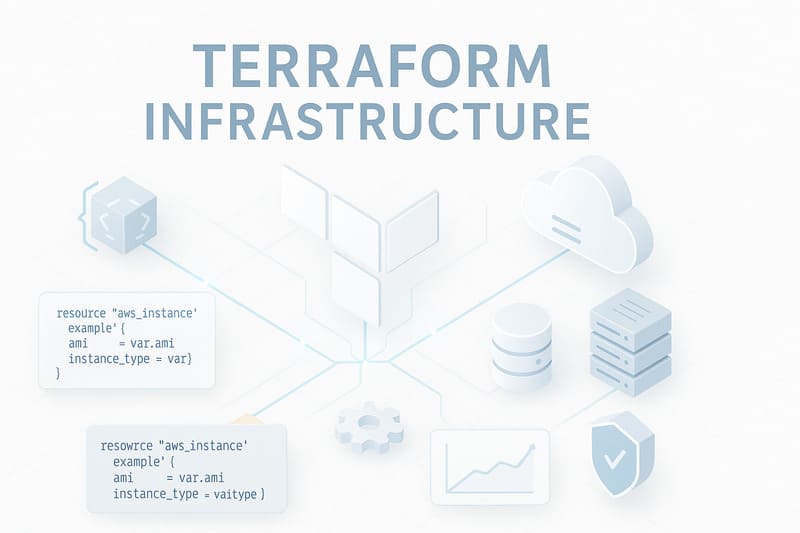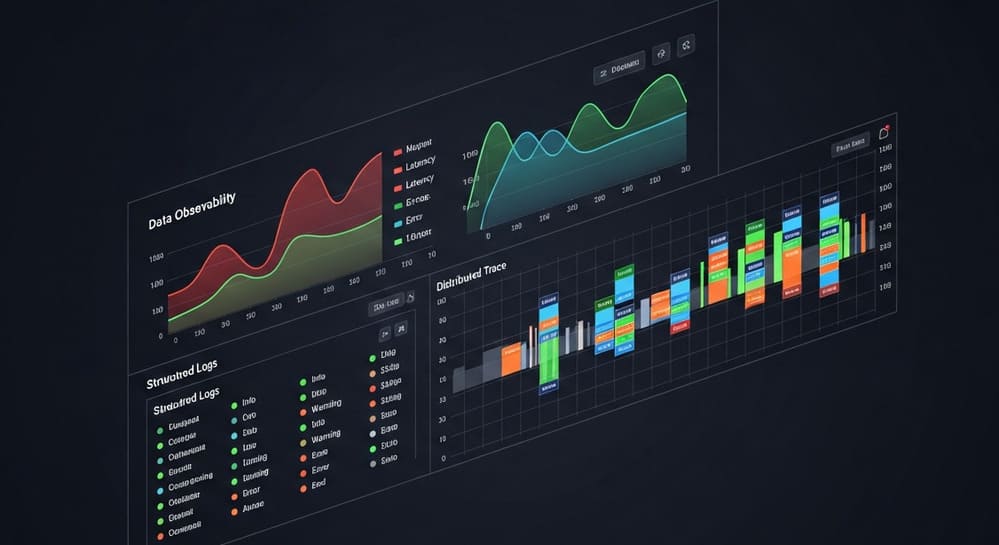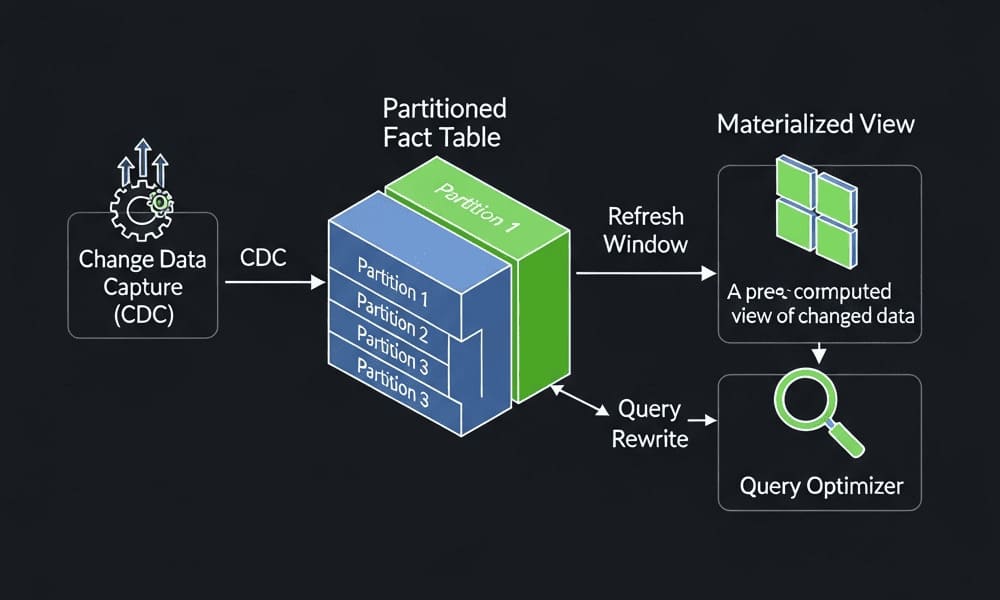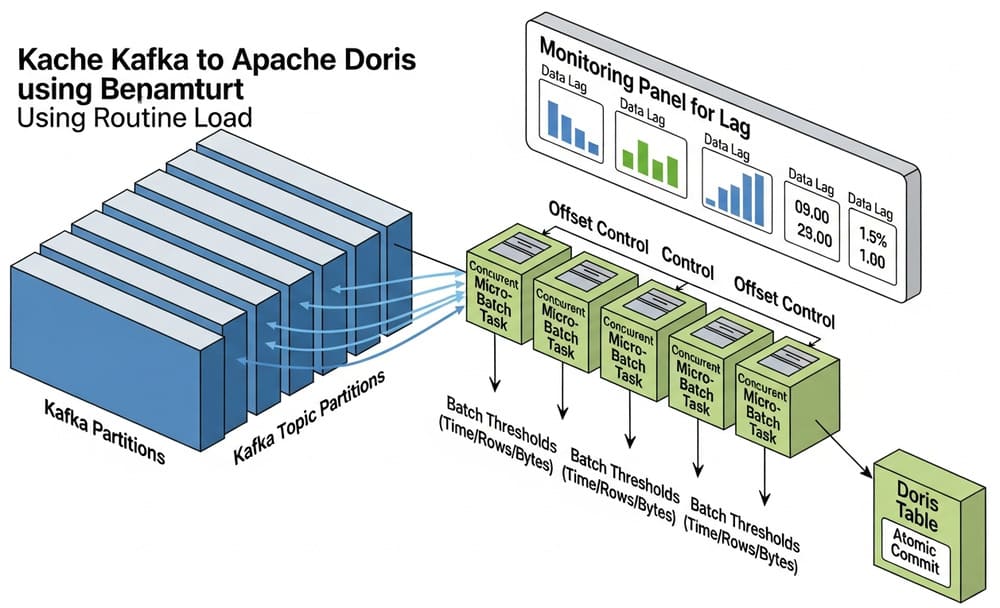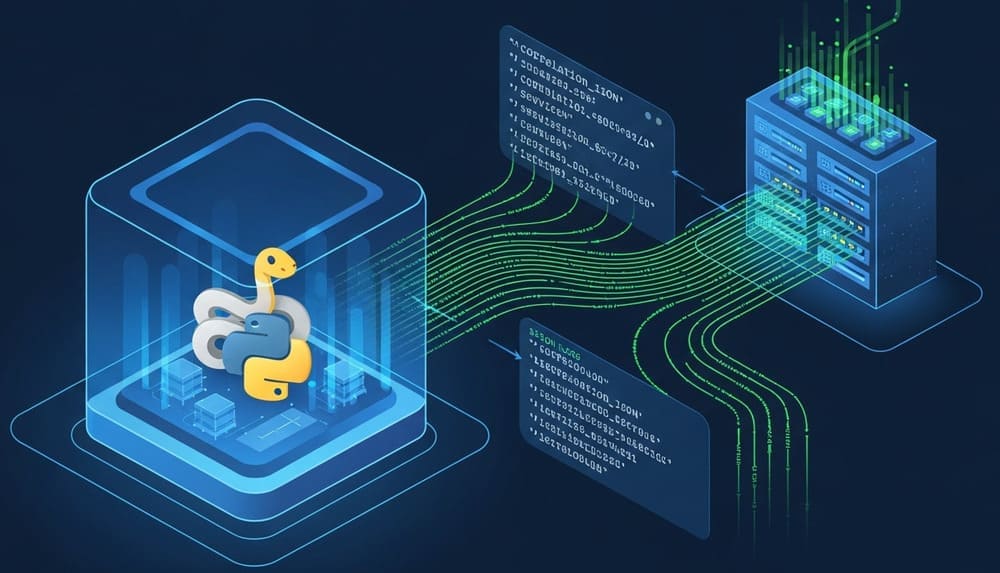Terraform for Data Engineering: Building Scalable Cloud Infrastructure with Infrastructure as Code
Data engineering teams are increasingly adopting Infrastructure as Code (IaC) to manage complex cloud environments that support modern data pipelines, ML workflows, and analytics platforms. Terraform has emerged as the leading IaC tool, enabling teams to provision, manage, and scale data infrastructure with unprecedented consistency and reliability.
This comprehensive guide explores how data engineers can leverage Terraform to build robust, scalable infrastructure for data-intensive workloads, covering everything from basic concepts to advanced patterns used in production environments.
Why Terraform is Essential for Modern Data Engineering
The Infrastructure Challenge in Data Engineering
Modern data engineering involves orchestrating complex ecosystems of services: data warehouses, streaming platforms, container orchestration, ML training clusters, and monitoring systems. Managing these resources manually leads to:
- Configuration drift between environments
- Inconsistent deployments across development, staging, and production
- Time-consuming manual provisioning that doesn’t scale
- Lack of version control for infrastructure changes
- Difficulty in disaster recovery and environment replication
Terraform’s Advantages for Data Teams
Declarative Infrastructure Management: Define your desired infrastructure state, and Terraform handles the execution details.
Multi-Cloud Support: Manage resources across AWS, Azure, GCP, and other providers from a single configuration.
State Management: Terraform tracks resource dependencies and state, enabling safe updates and rollbacks.
Modular Design: Create reusable infrastructure components that can be shared across projects and teams.
Integration-Friendly: Works seamlessly with CI/CD pipelines, version control, and other DevOps tools.
Core Terraform Concepts for Data Engineers
Infrastructure as Code Fundamentals
Terraform uses HashiCorp Configuration Language (HCL) to define infrastructure resources. Here’s a basic example creating an AWS S3 bucket for data storage:
# Configure the AWS Provider
terraform {
required_providers {
aws = {
source = "hashicorp/aws"
version = "~> 5.0"
}
}
required_version = ">= 1.0"
}
provider "aws" {
region = var.aws_region
}
# Create S3 bucket for data lake
resource "aws_s3_bucket" "data_lake" {
bucket = "${var.project_name}-data-lake-${var.environment}"
tags = {
Environment = var.environment
Project = var.project_name
Team = "data-engineering"
}
}
# Configure bucket versioning
resource "aws_s3_bucket_versioning" "data_lake_versioning" {
bucket = aws_s3_bucket.data_lake.id
versioning_configuration {
status = "Enabled"
}
}
# Set up bucket encryption
resource "aws_s3_bucket_server_side_encryption_configuration" "data_lake_encryption" {
bucket = aws_s3_bucket.data_lake.id
rule {
apply_server_side_encryption_by_default {
sse_algorithm = "AES256"
}
}
}
State Management and Remote Backends
Terraform state files track resource metadata and dependencies. For team environments, use remote backends:
terraform {
backend "s3" {
bucket = "my-terraform-state-bucket"
key = "data-platform/terraform.tfstate"
region = "us-west-2"
encrypt = true
dynamodb_table = "terraform-state-locks"
}
}
Variables and Environment Management
Use variables to make configurations reusable across environments:
# variables.tf
variable "environment" {
description = "Environment name (dev, staging, prod)"
type = string
validation {
condition = contains(["dev", "staging", "prod"], var.environment)
error_message = "Environment must be dev, staging, or prod."
}
}
variable "data_retention_days" {
description = "Number of days to retain data"
type = number
default = 30
}
variable "instance_types" {
description = "EC2 instance types for different workloads"
type = object({
airflow = string
spark = string
jupyter = string
})
default = {
airflow = "t3.medium"
spark = "m5.xlarge"
jupyter = "t3.large"
}
}
Building a Complete Data Engineering Infrastructure
Multi-Tier Data Architecture with Terraform
Let’s build a comprehensive data platform including data ingestion, processing, storage, and analytics layers:
# main.tf - Complete data platform infrastructure
# VPC and Networking
module "vpc" {
source = "terraform-aws-modules/vpc/aws"
name = "${var.project_name}-vpc"
cidr = "10.0.0.0/16"
azs = ["us-west-2a", "us-west-2b", "us-west-2c"]
private_subnets = ["10.0.1.0/24", "10.0.2.0/24", "10.0.3.0/24"]
public_subnets = ["10.0.101.0/24", "10.0.102.0/24", "10.0.103.0/24"]
enable_nat_gateway = true
enable_vpn_gateway = false
tags = local.common_tags
}
# EKS Cluster for Container Workloads
module "eks" {
source = "terraform-aws-modules/eks/aws"
cluster_name = "${var.project_name}-eks"
cluster_version = "1.28"
vpc_id = module.vpc.vpc_id
subnet_ids = module.vpc.private_subnets
node_groups = {
data_processing = {
desired_capacity = 2
max_capacity = 10
min_capacity = 1
instance_types = ["m5.large"]
k8s_labels = {
Environment = var.environment
Workload = "data-processing"
}
}
}
tags = local.common_tags
}
# RDS for Metadata Store
resource "aws_db_instance" "metadata_db" {
identifier = "${var.project_name}-metadata-db"
engine = "postgres"
engine_version = "15.4"
instance_class = "db.t3.micro"
allocated_storage = 20
max_allocated_storage = 100
db_name = "metadata"
username = var.db_username
password = var.db_password
vpc_security_group_ids = [aws_security_group.rds.id]
db_subnet_group_name = aws_db_subnet_group.main.name
backup_retention_period = 7
backup_window = "03:00-04:00"
maintenance_window = "sun:04:00-sun:05:00"
skip_final_snapshot = var.environment != "prod"
tags = local.common_tags
}
# MSK for Streaming Data
resource "aws_msk_cluster" "data_streaming" {
cluster_name = "${var.project_name}-kafka"
kafka_version = "2.8.1"
number_of_broker_nodes = 3
broker_node_group_info {
instance_type = "kafka.m5.large"
ebs_volume_size = 100
client_subnets = module.vpc.private_subnets
security_groups = [aws_security_group.msk.id]
}
configuration_info {
arn = aws_msk_configuration.kafka_config.arn
revision = aws_msk_configuration.kafka_config.latest_revision
}
encryption_info {
encryption_in_transit {
client_broker = "TLS"
in_cluster = true
}
}
tags = local.common_tags
}
# Redshift for Data Warehousing
resource "aws_redshift_cluster" "data_warehouse" {
cluster_identifier = "${var.project_name}-redshift"
database_name = "analytics"
master_username = var.redshift_username
master_password = var.redshift_password
node_type = "dc2.large"
cluster_type = "single-node"
vpc_security_group_ids = [aws_security_group.redshift.id]
db_subnet_group_name = aws_redshift_subnet_group.main.name
skip_final_snapshot = var.environment != "prod"
tags = local.common_tags
}
# EMR for Big Data Processing
resource "aws_emr_cluster" "spark_cluster" {
name = "${var.project_name}-spark-cluster"
release_label = "emr-6.15.0"
applications = ["Spark", "Hadoop", "Hive", "Jupyter"]
ec2_attributes {
subnet_id = module.vpc.private_subnets[0]
emr_managed_master_security_group = aws_security_group.emr_master.id
emr_managed_slave_security_group = aws_security_group.emr_slave.id
instance_profile = aws_iam_instance_profile.emr_profile.arn
}
master_instance_group {
instance_type = "m5.xlarge"
}
core_instance_group {
instance_type = "m5.xlarge"
instance_count = 2
ebs_config {
size = 40
type = "gp2"
volumes_per_instance = 1
}
}
tags = local.common_tags
}
Security and IAM Configuration
Implement proper security controls for your data infrastructure:
# security.tf - Security configurations
# Security Groups
resource "aws_security_group" "rds" {
name_prefix = "${var.project_name}-rds-"
vpc_id = module.vpc.vpc_id
ingress {
from_port = 5432
to_port = 5432
protocol = "tcp"
security_groups = [aws_security_group.app_servers.id]
}
egress {
from_port = 0
to_port = 0
protocol = "-1"
cidr_blocks = ["0.0.0.0/0"]
}
tags = merge(local.common_tags, {
Name = "${var.project_name}-rds-sg"
})
}
# IAM Roles for Data Processing
resource "aws_iam_role" "data_processing_role" {
name = "${var.project_name}-data-processing-role"
assume_role_policy = jsonencode({
Version = "2012-10-17"
Statement = [
{
Action = "sts:AssumeRole"
Effect = "Allow"
Principal = {
Service = "ec2.amazonaws.com"
}
}
]
})
}
resource "aws_iam_role_policy_attachment" "data_processing_s3" {
role = aws_iam_role.data_processing_role.name
policy_arn = "arn:aws:iam::aws:policy/AmazonS3FullAccess"
}
# KMS Key for Encryption
resource "aws_kms_key" "data_encryption" {
description = "KMS key for data platform encryption"
deletion_window_in_days = 7
tags = local.common_tags
}
resource "aws_kms_alias" "data_encryption" {
name = "alias/${var.project_name}-data-encryption"
target_key_id = aws_kms_key.data_encryption.key_id
}
Advanced Terraform Patterns for Data Engineering
Modular Architecture with Terraform Modules
Create reusable modules for common data engineering patterns:
# modules/data-pipeline/main.tf
variable "pipeline_name" {
description = "Name of the data pipeline"
type = string
}
variable "source_bucket" {
description = "S3 bucket for source data"
type = string
}
variable "target_bucket" {
description = "S3 bucket for processed data"
type = string
}
# Lambda function for data processing
resource "aws_lambda_function" "data_processor" {
filename = "data_processor.zip"
function_name = "${var.pipeline_name}-processor"
role = aws_iam_role.lambda_role.arn
handler = "index.handler"
runtime = "python3.9"
timeout = 300
environment {
variables = {
SOURCE_BUCKET = var.source_bucket
TARGET_BUCKET = var.target_bucket
}
}
}
# EventBridge rule for scheduling
resource "aws_cloudwatch_event_rule" "pipeline_schedule" {
name = "${var.pipeline_name}-schedule"
description = "Trigger data pipeline"
schedule_expression = "rate(1 hour)"
}
resource "aws_cloudwatch_event_target" "lambda_target" {
rule = aws_cloudwatch_event_rule.pipeline_schedule.name
target_id = "TriggerLambda"
arn = aws_lambda_function.data_processor.arn
}
# Output the Lambda function ARN
output "processor_function_arn" {
value = aws_lambda_function.data_processor.arn
}
Multi-Environment Management
Structure your Terraform code for multiple environments:
# environments/prod/main.tf
module "data_platform" {
source = "../../modules/data-platform"
environment = "prod"
# Production-specific configurations
instance_types = {
airflow = "m5.large"
spark = "m5.2xlarge"
jupyter = "m5.xlarge"
}
# Enable high availability
multi_az = true
# Production data retention
data_retention_days = 2555 # 7 years
# Backup configurations
backup_retention_period = 30
tags = {
Environment = "prod"
CostCenter = "data-engineering"
Owner = "data-team"
}
}
Terraform Workspaces for Environment Isolation
# Create and manage workspaces
terraform workspace new dev
terraform workspace new staging
terraform workspace new prod
# Use workspace-specific variables
terraform workspace select prod
terraform apply -var-file="environments/prod/terraform.tfvars"
Best Practices for Terraform in Data Engineering
1. State Management and Remote Backends
Always use remote backends for team collaboration:
terraform {
backend "s3" {
bucket = "my-terraform-state"
key = "data-platform/terraform.tfstate"
region = "us-west-2"
# Enable state locking
dynamodb_table = "terraform-locks"
encrypt = true
}
}
2. Resource Tagging Strategy
Implement consistent tagging for cost management and governance:
locals {
common_tags = {
Project = var.project_name
Environment = var.environment
Team = "data-engineering"
CreatedBy = "terraform"
CostCenter = var.cost_center
}
}
# Apply tags to all resources
resource "aws_instance" "example" {
# ... other configuration
tags = merge(local.common_tags, {
Name = "example-instance"
Role = "data-processing"
})
}
3. Sensitive Data Management
Use Terraform’s sensitive variables and external secret management:
variable "database_password" {
description = "Database password"
type = string
sensitive = true
}
# Use AWS Secrets Manager
data "aws_secretsmanager_secret_version" "db_password" {
secret_id = "data-platform/db-password"
}
resource "aws_db_instance" "main" {
password = jsondecode(data.aws_secretsmanager_secret_version.db_password.secret_string)["password"]
# ... other configuration
}
4. Resource Dependencies and Lifecycle Management
Handle resource dependencies explicitly:
resource "aws_db_instance" "main" {
# ... configuration
depends_on = [
aws_db_subnet_group.main,
aws_security_group.rds
]
lifecycle {
prevent_destroy = true
ignore_changes = [
password, # Managed externally
tags["LastModified"]
]
}
}
5. Automated Testing and Validation
Implement infrastructure testing:
# Use terraform validate and plan in CI/CD
# Example GitHub Actions workflow
name: Terraform CI/CD
on:
pull_request:
branches: [main]
push:
branches: [main]
jobs:
terraform:
runs-on: ubuntu-latest
steps:
- uses: actions/checkout@v3
- uses: hashicorp/setup-terraform@v2
- name: Terraform Format Check
run: terraform fmt -check
- name: Terraform Validate
run: terraform validate
- name: Terraform Plan
run: terraform plan -out=tfplan
- name: Apply on Main
if: github.ref == 'refs/heads/main'
run: terraform apply tfplan
Monitoring and Observability
Infrastructure Monitoring with Terraform
Set up comprehensive monitoring for your data infrastructure:
# CloudWatch Alarms for Data Pipeline Monitoring
resource "aws_cloudwatch_metric_alarm" "lambda_errors" {
alarm_name = "${var.project_name}-lambda-errors"
comparison_operator = "GreaterThanThreshold"
evaluation_periods = "2"
metric_name = "Errors"
namespace = "AWS/Lambda"
period = "300"
statistic = "Sum"
threshold = "5"
alarm_description = "This metric monitors lambda errors"
dimensions = {
FunctionName = aws_lambda_function.data_processor.function_name
}
alarm_actions = [aws_sns_topic.alerts.arn]
}
# SNS Topic for Alerts
resource "aws_sns_topic" "alerts" {
name = "${var.project_name}-alerts"
}
# CloudWatch Dashboard
resource "aws_cloudwatch_dashboard" "data_platform" {
dashboard_name = "${var.project_name}-data-platform"
dashboard_body = jsonencode({
widgets = [
{
type = "metric"
x = 0
y = 0
width = 12
height = 6
properties = {
metrics = [
["AWS/Lambda", "Duration", "FunctionName", aws_lambda_function.data_processor.function_name],
[".", "Errors", ".", "."],
[".", "Invocations", ".", "."]
]
view = "timeSeries"
stacked = false
region = var.aws_region
title = "Lambda Metrics"
period = 300
}
}
]
})
}
Cost Optimization Strategies
1. Right-sizing Resources
Use data-driven approaches to optimize instance sizes:
# Use spot instances for batch processing
resource "aws_emr_instance_group" "core" {
cluster_id = aws_emr_cluster.main.id
instance_type = "m5.xlarge"
instance_count = 3
# Use spot instances for cost optimization
bid_price = "0.30" # Adjust based on spot price analysis
ebs_config {
size = 100
type = "gp3"
}
}
2. Automated Scaling
Implement auto-scaling based on workload patterns:
# Auto Scaling for EKS Node Groups
resource "aws_autoscaling_policy" "scale_up" {
name = "scale-up"
scaling_adjustment = 2
adjustment_type = "ChangeInCapacity"
cooldown = 300
autoscaling_group_name = module.eks.node_groups.data_processing.asg_name
}
resource "aws_cloudwatch_metric_alarm" "cpu_high" {
alarm_name = "cpu-utilization-high"
comparison_operator = "GreaterThanThreshold"
evaluation_periods = "2"
metric_name = "CPUUtilization"
namespace = "AWS/EC2"
period = "300"
statistic = "Average"
threshold = "80"
alarm_actions = [aws_autoscaling_policy.scale_up.arn]
}
Troubleshooting Common Issues
State File Management Issues
Problem: State file conflicts in team environments Solution: Use remote backends with state locking
# Initialize with remote backend
terraform init -backend-config="bucket=my-terraform-state"
# Check state
terraform state list
terraform state show aws_s3_bucket.data_lake
# Import existing resources
terraform import aws_s3_bucket.data_lake my-existing-bucket
Resource Drift Detection
Problem: Infrastructure drift from manual changes Solution: Regular drift detection and remediation
# Check for drift
terraform plan -detailed-exitcode
# Refresh state
terraform refresh
# Force resource recreation if needed
terraform taint aws_instance.example
terraform apply
Dependency Issues
Problem: Resource creation order issues Solution: Explicit dependency management
resource "aws_instance" "app_server" {
# ... configuration
depends_on = [
aws_security_group.app_sg,
aws_subnet.private
]
}
Key Takeaways and Next Steps
Essential Takeaways
Start with Remote State: Always configure remote backends for team collaboration and state management.
Embrace Modularity: Design reusable modules for common data engineering patterns to improve maintainability and consistency.
Implement Proper Security: Use IAM roles, security groups, and encryption to protect your data infrastructure.
Monitor and Optimize: Set up comprehensive monitoring and implement cost optimization strategies from day one.
Automate Testing: Integrate Terraform validation and testing into your CI/CD pipelines.
Next Steps for Implementation
- Assessment Phase: Audit your current infrastructure and identify components suitable for Terraform management
- Pilot Project: Start with a non-critical environment to gain experience and establish best practices
- Module Development: Create organization-specific modules for common data engineering patterns
- CI/CD Integration: Implement automated testing and deployment pipelines for infrastructure changes
- Team Training: Ensure your team is trained on Terraform best practices and troubleshooting techniques
Recommended Learning Resources
- Official Terraform Documentation: terraform.io/docs
- AWS Provider Documentation: registry.terraform.io/providers/hashicorp/aws
- Terraform Best Practices: HashiCorp’s official best practices guide
- Community Modules: Explore proven modules at registry.terraform.io
By implementing Infrastructure as Code with Terraform, data engineering teams can achieve greater consistency, reliability, and scalability in their cloud infrastructure management. The investment in learning and implementing these practices pays dividends through reduced operational overhead, improved disaster recovery capabilities, and enhanced collaboration across teams.
Start small, think modular, and gradually expand your Terraform adoption to transform how your organization manages data infrastructure at scale.

